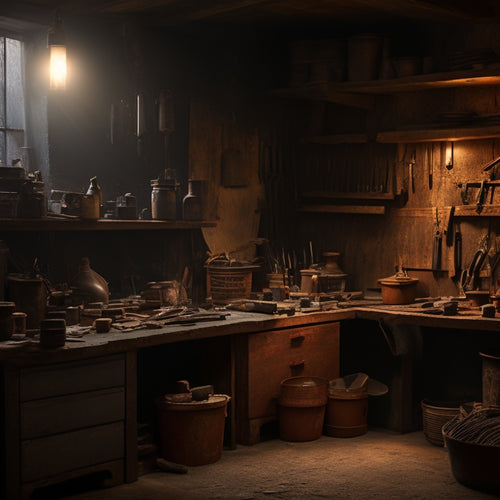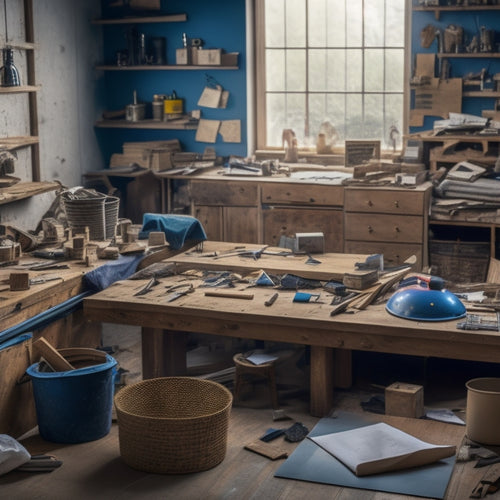
Create a Perfect Wall With This Renovation Checklist
Share
You're about to transform a blank space into a stunning wall, and the success of your project hinges on a solid plan and precise execution. Prepare your site by clearing the area, setting up equipment, and establishing a waste management system. Choose the right concrete mix, tailored to your project's needs, and calculate the quantities required with adjustments for waste and local building codes. Mix and pour the concrete with care, ensuring a safe working environment and proper techniques. Finally, cure and finish the wall to achieve your desired texture and design. By following these steps, you'll be well on your way to creating a perfect wall that meets your vision.
Key Takeaways
• Clear the site of furniture, fixtures, and flooring to prevent damage and ensure a smooth renovation process.
• Select the right concrete mix tailored to the project's needs for strength, durability, and aesthetic goals.
• Calculate concrete quantities accurately, considering waste estimation, thickness adjustments, and local building codes.
• Mix and pour concrete safely and efficiently, using proper techniques and additives for improved strength and workability.
• Cure and finish the wall properly, using curing compounds, damp cloths, and desired textures to achieve a strong and durable result.
Preparing the Construction Site
Before diving into the renovation process, clear the construction site by removing all furniture, fixtures, and flooring to prevent damage and guarantee a safe working environment. This vital step secures site safety and allows you to focus on the renovation without worrying about accidents or damage to your belongings.
Next, set up your equipment and tools in a way that promotes efficiency and accessibility. This includes positioning your power tools, ladders, and other essential equipment in a logical and organized manner. Make sure you have a clear path for moving materials and personnel around the site.
It's also important to establish a system for managing waste and debris. Designate a specific area for disposing of materials, and make certain you have the necessary supplies, such as trash bags and a dumpster, to keep the site clean and organized.
Selecting the Right Concrete Mix
You'll need to choose a concrete mix that suits your wall renovation project's specific requirements, taking into account factors such as load-bearing capacity, exposure to weather, and desired finish. A well-designed mix guarantees your wall can withstand various loads and environmental conditions, while also meeting your aesthetic goals.
When selecting a concrete mix, consider the following key factors:
-
Mix design: Confirm the mix is tailored to your project's specific needs, including compressive strength, workability, and durability. A poorly designed mix can lead to structural issues, cracking, or crumbling.
-
Aggregate selection: Choose aggregates that are suitable for your project's exposure conditions. For example, if your wall will be exposed to harsh weather, you may need to use aggregates that are resistant to freeze-thaw cycles.
-
Special requirements: Consider any special requirements, such as high-early strength, low shrinkage, or specific colors. This will help you achieve the desired finish and performance for your wall.
Calculating Concrete Quantities Needed
To guarantee you have enough concrete for your wall renovation project, calculate the total volume of concrete needed by multiplying the length, width, and height of each section, taking into account any obstructions or irregularities. This will give you the total volume in cubic feet or meters.
Next, you'll need to adjust this calculation to account for waste. A general rule of thumb is to add 10% to your total volume to allow for estimating waste, such as spills or uneven pours.
Additionally, consider adjusting thickness to make sure your wall can support the desired load. For example, if you're building a load-bearing wall, you may need to increase the thickness to guarantee structural integrity.
Don't forget to check local building codes and regulations for specific requirements. By accurately calculating your concrete needs, you'll avoid costly delays and make sure your wall renovation project stays on track.
Mixing and Pouring the Concrete
Now that you've calculated the amount of concrete needed, it's time to mix and pour it, a process that requires careful attention to detail to confirm a strong and durable wall.
To guarantee a successful pour, make sure you're prepared with the right equipment and a safe working environment. Wear protective gear, including gloves, safety glasses, and a dust mask, to prevent injury from the concrete and mixing process.
When mixing the concrete, follow these essential steps:
-
Use the right mixing techniques: Overmixing can lead to a weak and porous finish, so mix the concrete just until the ingredients are combined.
-
Add concrete additives as needed: Depending on the specific requirements of your project, you may need to add additives to improve the concrete's strength, workability, or durability.
-
Monitor the mix's consistency: Stop mixing when the concrete reaches a workable consistency, similar to thick batter.
Remember to pour the concrete slowly and evenly, and avoid over-vibrating the mixture, which can cause air pockets and weaknesses in the finished wall.
Curing and Finishing the Wall
Finish the concrete pour by leveling the surface and removing any excess material, then let the wall cure under a layer of curing compound or a damp cloth to prevent moisture loss and promote strength development. This step is essential, as it allows the concrete to reach its full potential strength and durability.
Once the concrete has cured, you can move on to surface treatment. You'll need to decide on the wall texture you want to achieve - smooth, rough, or anything in between. Use a trowel or float to apply a finish coat, working in small sections to maintain even coverage. For a smooth finish, use a steel trowel; for a rougher texture, use a wooden float.
Remember to follow safety guidelines when working with concrete, including wearing protective gear like gloves, safety glasses, and a dust mask. Keep the area well-ventilated, and avoid breathing in concrete dust.
With patience and attention to detail, you'll be rewarded with a strong, durable wall that meets your design vision.
Frequently Asked Questions
Can I Pour Concrete in Extreme Weather Conditions?
When you're planning to pour concrete, you're probably wondering if extreme weather conditions will affect the outcome. The answer is, it depends.
You shouldn't pour concrete in direct sunlight, high winds, or during freezing temperatures. However, with the right concrete pouring techniques and extreme weather considerations, you can still achieve a strong and durable finish.
Make certain to monitor the temperature, use the right mix, and protect the concrete from the elements to guarantee a successful pour.
How Do I Remove Old Wall Finishes Before Renovation?
You're about to commence on a wall renovation, but first, you need to remove old finishes.
Start by covering floors and furniture with drop cloths to contain the mess.
Wear protective gear, including gloves, goggles, and a mask.
Scrape off loose material with a putty knife or scraper, then apply a finish remover to break down adhesives.
Let it sit before scrubbing and rinsing.
This thorough wall preparation and finish removal process guarantees a smooth, safe, and successful renovation.
What Safety Gear Is Necessary for Concrete Renovation?
When tackling concrete renovation, you'll need the right safety gear to protect yourself from hazards.
First, grab a pair of safety goggles to shield your eyes from flying debris and concrete dust.
Don't forget a dust mask to filter out airborne particles that can irritate your lungs.
These essentials will help you breathe easy and see clearly, allowing you to focus on the task at hand.
Can I Use a Ready-Mix Concrete for My Wall Project?
The concrete conundrum! You're wondering if ready-mix concrete is the way to go for your wall project.
The good news is, yes, you can use it! Ready-mix concrete offers benefits like convenience, consistency, and time-saving.
However, it's essential to follow proper mixing techniques to guarantee a strong and durable finish. Make certain to follow the manufacturer's instructions and mix it to the recommended consistency to achieve a flawless wall that'll stand the test of time.
How Long Does It Take for Concrete to Fully Cure?
You're wondering how long it takes for concrete to fully cure. The curing time depends on factors like temperature, humidity, and concrete strength.
Generally, concrete reaches 70% of its strength within 7-10 days, but it can take up to 28 days to fully cure.
To guarantee safety, wait at least 24 hours before walking on it, and 7-10 days before applying heavy loads.
Always follow the manufacturer's instructions and local building codes for best results.
Conclusion
You've made it to the finish line!
Remember, 'Rome wasn't built in a day,' and neither is a perfect wall.
But with this renovation checklist, you've laid the foundation for a sturdy and durable structure.
By following these steps, you've guaranteed a strong base, precise calculations, and a flawless finish.
Stand back and admire your handiwork – your wall is now a symbol of your diligence and attention to detail.
Related Posts
-

Why Invest in Quality Plastering Tools for Renovation
When renovating, investing in quality plastering tools is essential for achieving professional-looking results and mi...
-

7 Best Home Renovation Project Checklists With Timelines
You're about to initiate a home renovation project, and establishing a clear plan with timelines is vital to staying ...
-

3 Best Planter Shopping Timeline Tips for Renovators
When incorporating planters into your renovation project, you'll want to plan carefully to avoid delays and guarantee...


